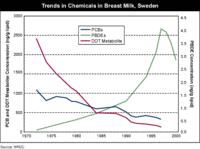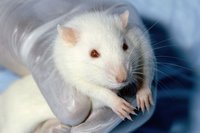Polybrominated diphenyl ethers (PBDEs)
This article was researched and written by a student at Mount Holyoke College participating in the Encyclopedia of Earth's (EoE) Student Science Communication Project. The project encourages students in undergraduate and graduate programs to write about timely scientific issues under close faculty guidance. All articles have been reviewed by internal EoE editors, and by independent experts on each topic.
Contents
Introduction The basic structure for PBDEs. (Source: Wikipedia (Polybrominated diphenyl ethers (PBDEs)) )
Polybrominated diphenyl ethers or PBDEs have been used commercially as flame-retardants in electrical appliances, carpets, furniture, and in polyurethane foam since the 1970s. Since PBDEs do not bind chemically to polymers in textiles or plastics, they can leach out and be washed down sink and shower drains or become part of household or office dust, where they can be present in high concentrations. Also, PBDEs can be introduced into water and air during manufacture or combustion of household appliances. They are bioaccumulative and lipophilic. They are found in highest concentrations, therefore, in the fats of top predators worldwide. Much of the concern surrounding PBDEs exists because they are found in human breast milk. Many PBDEs have been banned in Europe and in some states in the United States (U.S.). Certain PBDEs, however, continue to be produced globally at a rate of 200,000 tons annually—the U.S. being one of the highest producers and consumers worldwide.
Types of PBDEs
There are potentially 209 congeners of PBDEs. Congeners differ by the number and location of bromine atoms. Among the PBDEs most widely used and most prevalent in animal tissues are the commercial mixtures: penta-, octa-, and deca-BDE.
- Penta-BDEs have been used mainly in the United States in foam cushions for furniture and polyurethane foams. One congener in penta-BDE of note is BDE-47, which often accounts for the highest concentration of PBDEs in human and wildlife tissues. Penta-BDEs have not been produced in the U.S. since December 2004 and have been banned by some states in the U.S. A ban on penta-BDEs was passed in the European Union in July of 2004.
- Octa-BDE is used mainly in the plastics of many electronics including computers and is not a major product worldwide. U.S. industries stopped producing octa-BDEs voluntarily in December of 2004, though there is no federal ban on use of existing stocks. Octa-BDEs have been banned by some states in the U.S. and have been banned in the European Union since July 2004.
- Deca-BDE is used in wire and cable insulating plastics as well as casing for many electronics as well as the backing of heavy textiles. A ten-year scientific risk assessment of deca-BDE by the European Union concluded that there was a lack of recognized risks associated with use of deca-BDE, and that no restrictions on its use were necessary.
PBDEs and Fire

PBDEs work as flame-retardants by releasing inert bromine gas at high temperatures. This gas coats appliances, displacing oxygen and making them harder to burn. Part of the reason why the United States uses so many PBDEs is because of fire prevention policies and regulations. In the last 25 years, fire incidence in the U.S. has dropped.
PBDE Concentrations in Humans

PBDEs are found in humans around the world. The concentrations and types of PBDEs in people vary depending on country, city, occupation, and diet. The main routes of exposure to PBDEs change throughout life. Infants, for example, are exposed primarily through breast milk, while toddlers are exposed through contact with household dust. In the U.S., 80% of adult exposure is accounted for by inhalation and ingestion of dust. However, in Europe, where concentrations of PBDEs in dust are much lower, diet is a more significant source.
Sweden has monitored human breast milk since the 1970s. Concentrations of measured PBDEs have increased since the start of the program up to 1997, when levels began to decline—possibly due to the decline in use of Penta-BDEs in Europe in the 1990s.
Milk from women from the U.S. and Canada contains many times the amount of PBDEs than that of women from Sweden and Japan. The last 30 years show a dramatic increase in levels of PBDEs in the breast milk of American women. Women from the U.S. generally contain 10-100 times more PBDEs in their breast milk than women from Europe.
| Country | Concentration (ppb Lipid) |
|---|---|
| Sweden | 3.2 |
| Japan | 1.4 |
| Canada | 25 |
| United States | 41 |
In some Asian and countries, which tend to have low labor costs and lax environmental regulation, recycling (Polybrominated diphenyl ethers (PBDEs)) of electronic goods by villagers presents health risks, in part because of chemicals like PBDEs. Brominated dioxins and furans can form when plastics containing PDBEs burn at low temperatures. When people “bake” plastics at dumps to recover metals, the release of contaminants presents health risks and raises issues of Environmental Justice. Recent studies show high levels of various PBDEs in people working at municipal waste disposal sites in Managua, Nicaragua.
Studies Regarding the Effects of PBDEs
There has been much concern regarding increasing levels of PBDE in humans because studies show that there are health effects in animals fed PBDEs. Early studies showed that very high doses of deca-BDEs caused neoplastic nodules in the livers of male and female rats, low incidence of thyroid tumors, and delay in reproductive development of male rats.
More recent studies using lower doses showed neurobehavioral alterations and thyroid dysfunction in male and female mice. This may be due to the similarity in structure of PBDEs to thyroxine, the main hormone produced by the thyroid gland. This similarity could result in disruption of thyroid hormone metabolism and transport. Since the thyroid controls growth, development and reproduction, interference with thyroid hormone balance is of great concern.
PBDEs in the Environment
Concentrations of PBDEs in sediments and sewage sludge, fish, marine mammals, and humans are shown in Table 2. Although concentrations of PBDEs are increasing in humans, concentrations are even greater in some marine mammals and in such terrestrial birds of prey as peregrine falcons.
| Subject | Location | PBDEs (ppb) | Source |
|---|---|---|---|
| Sediments | Major river basins of Portugal | 0.000 03- 0.1 dry weight | Lacorte 2003 |
| Sewage sludge | United States | 33,000 | Hale et al. 2002 |
| Breastmilk | Women from Texas | 6.2 – 419 lipid, mean of 73.9 lipid | Schecter et al 2003 |
| Farmed fish | Southern Chile | 1.46 wet weight 12-20 lipid weight | Montory 2006 |
| Dungeness crab | West coast, Canada; 1993-1995 | 4.2-480 lipid | Ikonomou et al. 2002 |
| Bald eagle egg | Lower Columbia River, Washington and Oregon, 1994-1995 | 446-1,206 wet weight | Buck et al. 1999 |
| Average for fish | California Coast, 2000 | 302.17 lipid | Brown et al. 2006 |
| Speckled sanddab | Eureka/Arcata, California Coast, 2000 | 13.25 lipid | Brown et al. 2006 |
| Shiner surf perch | San Francisco Waterfront, CA, 2000 | 314.45 lipid | Brown et al. 2006 |
| Shiner surf perch | Mission Bay/Crown Point, California Coast, 2000 | 1023.75 lipid | Brown et al. 2006 |
| Canary rockfish | Santa Cruz, CA, 2000 | 281.98 lipid | Brown et al. 2006 |
| Harbor Seal Fat | Puget Sound, WA 2000 | 1,064 lipid | www.epa.gov |
| Harbor Seal Fat | Vancouver, British Columbia | 497 lipid | www.epa.gov |
| Harbor seals | Dutch Coast, Atlantic Ocean | 1,000 lipid | de Boer et al. 1998 |
| Whitebeaked dolphin | Dutch Coast, Atlantic Ocean | 7,000 lipid | de Boer et al. 1998 |
| Orca blubber | Northeaster Pacific Ocean, 1993-1996 | 87-1,629 lipid | Rayne et al. 2004 |
| Beluga whale blubber | Canadian Arctic | 17.2-160 lipid | Alaee et al. 1999 |
| Beluga whale blubber | St. Lawrence Estuary, Canada 1988-1999 | 17.2-935 lipid | Lebeuf et al. 2004 |
| Sperm whale blubber | Dutch Coast, Atlantic Ocean | 100 lipid | de Boer et al. 1998 |
The Future of PBDEs

According to the Washington State Department of Health's PBDE Chemical Action Plan there are alternatives to producing products containing PDBEs. One option is to use the least toxic or least persistent flame-retardants available. One issue with this approach is that many “alternative chemicals” have yet to be tested (for example, under the U.S. Toxic Substances Control Act) for human and environmental health effects, their impacts, therefore, are largely unknown. Another option is to design products in a way that makes them less flammable without the use of flame-retardants.
References
- Healthy milk, healthy baby. 2005. Natural Resources Defense Council.
- Is it in us. 2007. Coming Clean.
- Snuffing out brominated flame retardants. 2007. Toxic Nation, Environmental Defense.
- Toxics in harbor seals. 2006. Environmental Protection Agency.
- Washington State PBDE Chemical Action Plan: Final Plan. 2006. Department of Ecology Publications Distributions Office, Washington State Department of Health.
- Alaee, M, J. Luross, D.B. Sergeant, D.C. Muir, D.M. Whittle, K. Solomon. 1999. Distribution of polybrominated diphenyl ethers in the Canadian environment. Organohalogen Compounds. 40: 347-350.
- Athanasiadou, M., S. N. Cuadra, G. Marsh, A. Bergman, and K. Jakobsson. Polybrominated Dipheny ethers (PBDEs) and bioaccumulative hydroxylated PBDE metabolites in young humans from Managua, Nicaragua. Environmental Health Perspectives. 116 (3): 400-408.
- Birnbaum, L.S., D.F. Staskal. 2004. Brominated Flame Retardants: Cause for Concern?. Environmental Health Perspectives. 112 (1): 9-17.
- Brown, F.R., J. Winkler, P. Visita, J. Dhaliwal, M. Petreas. 2006. Levels of PBDEs, PCDDs, PCDFs, and coplanar PCBs in edible fish from California coastal waters. Chemosphere. 64: 276-286.
- De Boer, J., P.G. Wester, H.J.C. Klamer, W.E. Lewis, J.P. Boon. 1998. Do flame retardants threaten ocean life? Nature. 394: 28-29.
- Buck, J.A., R.G. Anthony, C.A. Schuler, F. Isaacs. 2005. Changes in productivity and contaminants in bald eagles nesting along the lower Columbia River, USA. Environmental Toxicology and Chemistry. 24 (17): 1779-1792.
- Deng, W.J., J.S. Zheng, X.H. Bi, J.M. Fu, M.H. Wong. 2007. Distribution of PBDEs in air particles from an electronic waste recycling site compared with Guangzhou and Hong Kong, South China. Environment International. 33: 1063-1069.
- Eriksson P, Viberg H, Jakobsson E, Orn U, Fredriksson A. 2002b. A brominated flame retardant, 2,2’,4,4’,5-pentabromodiphenyl ether: uptake, retention, and induction of neurobehavioral alterations in mice during a critical phase of neonatal brain development. Toxicological Science. 67: 98–103.
- Hale, R.C., M.J. La Guardia, E.P. Harvey, M. Mainor. 2002. Potential role of fire retardant-treated polyurethane foam as a source of brominated diphenyl ethers to the U.S. environment. Chemosphere. 46: 729-735.
- Ikonomou, M.G., S. Rayne, M. Fischer, M.P. Fernandez and W. Cretney. 2001. Occurrence and congener profiles of polybrominated diphenyl ethers (PBDEs) in environmental samples from coastal British Columnbia, Canada. Chemosphere. 46 (5): 649-663.
- Lebeuf, M., B. Gouteux, L. Measures, S. Trottier. 2004. Levels and Temporal Trends (1988-1999) of Polybrominated Diphenyl Ethers in Beluga Whales (Delphinapterus leucas) from the St. Lawrence Estuary, Canada. Environmental Science Technology. 38 (11): 2971-2977.
- Main, K.M.,H. Kiviranta, H.E. Virtanen, E.Sundqvist, J.T. Toumisto, J. Tuomisto, T. Vartiainen, N.E. Skakkenbaek, and J. Toppari. 2007. Flame retardants in placenta and breast milk and cryptorchidsm in newborn boys. Environmental Health Perspectives. 115 (10): 1519-1526.
- Martin, M., P.K.S. Lam, B.J. Richardson. 2004. An Asian quandary: where have all of the PBDEs gone? Marine Pollution Bulletin. 49: 375-382.
- Meironyte D, Noren K, Bergman A. 1999. Analysis of polybrominated diphenyl ethers in Swedish human milk. A time-related trend study, 1972–1997. J Toxicological Environmental Health. 58: 329–341.
- Petreas M, She J, Brown R, Winkler J, Winham G, Rogers E, et al. 2003. High body burdens of 2,2’4,4’-tetrabromodiphenyl ether (BDE-47) in California women. Environmental Health Perspectives. 111: 1175–1180.
- Rayne, S., M.G. Ikonomou, B. Antcliffe. 2003. Rapidly increasing PBDEs in the Columnbia River system from 1992 to 2000. American Chemical Society. 37 (13): 2847-2854.
- Schecter, A., M. Pavuk, O. Papke, J.J. Ryan, L. Birnbaum, and R. Rosen. 2003. Polybrominated diphenyl ethers (PBDEs) in U.S. Mothers’ Milk. Environmental Health Perspectives. 111 (14): 1725-1729.
- Schubert, Charlotte. 2001. Burned by flame retardants? Science News. 160 (15): 238-239.
- Snedeker, Suzanne. 2007. PBDEs - Polybrominated diphenyl ethers. Breast Cancer and Environmental Risk Factors Briefs. February 2007.
- Stiffler, Lisa. 2007. PBDEs: They are everywhere, they accumulate and they spread. Seattle Post-Intelligencer. 28 March 2007
- Qu, Weiyue, X. Bi, G. Sheng, S. Lu, J. Fu, J. Yuan, L. Li. 2007. Exposure to polybrominated diphenyl ethers among workers at an electronic waste dismantling region in Guangdong, China. Environment International. 33: 1029-1034.
Further Reading
- Biomonitoring
- Biomonitoring in wildlife
- Human biomonitoring
- German Environmental Surveys (GerESs)
- Animal testing alternatives
